Farming is not fun in Gaza
Report by Radmila Stojanovic in Gaza
Gaza did not have its usual rainy season in November and December. The situation got quite desperate about a month ago and special prayers were said in the mosques asking for the rain as the farmers were running out of time to sow their wheat.
Then, luckily, there were two welcome heavy rain downpours over the last month in time for the wheat sowing. Now another one is badly needed to get it growing.
In the past, the farmers did not rely on the elements and prayers so much. Instead, until very recently, they had irrigation systems, with concrete reservoirs collecting rain water and being topped up from the water mains. This water was than distributed via a network of plastic pipes through the fields.
Gaza has a 1,500-year recorded tradition of farming and many travellers and conquerors have described it through the centuries as a green oasis packed with trees and planted fields.
It is hard to imagine it now, but in the middle ages Gaza was famous for its wines, which were exported to France.
Nowadays, because Israelis have destroyed almost all concrete ‘pools’ on the border areas, farmers had to come up with alternative solutions.
In the areas further away from the border, they have dug big holes and lined them with the heavy plastic to collect the rain water. Near these reservoirs, they only plant the ‘thirsty’ crops such as courgettes, beans, cucumbers etc.
This was not an option for the fields near the border because those are dangerous places and even the briefest of visits can cost farmers their lives. Israelis have declared a couple of miles on the Palestinian side of the border to be a buffer area, a no-go zone where shooting down anything that moves is a fair game. Last year, there were 166 such attacks, in which 37 people were killed, 69 were injured and 26 properties were destroyed.
The 1993 Oslo Accords defined a buffer zone as a 50m security area, while Israel has air-dropped leaflets warning Palestinians against crossing the 300m mark. But in reality, according to the farmers and the Palestinian Centre for Human Rights, Israelis shoot at Palestinians as much as 2km away from the border.
For many farmers, giving up on their buffer-zone land, even to avoid death and injury or being kidnapped, is not an option. And not only because Gazan agricultural land is speedily disappearing due to the housing demands of a growing population.
In 2005, with the withdrawal of Israeli settlers from the strip, 30 percent of the most fertile land was reclaimed by Gazans, but now another 30 percent has been ‘lost’ to the buffer zones.
“We must farm our fields or we will give them up bit by bit and the next generation will not know how to work the land and will abandon it. We owe it to our children, regardless of dangers,” said a farmer who I met recently in the border village of Khuza’a, near Gaza’s second biggest town, Khan Younis.
He also told me that, 12 years ago, he had many fruit trees near the border, and that he used to get 20 boxes of fruit from each of his plum trees. He also grew vegetables in greenhouses which Israelis have since destroyed. “I used to sleep in the tent with my family in this very field,” he said with the nostalgia and sadness.
He cannot do this any more. Like many others, to minimise the chance of being shot at, on land near the border, he now plants only crops, such as wheat, that need very little water and almost no tending between sowing and harvesting. And he always asks the ISM to accompany him if he is farming there.
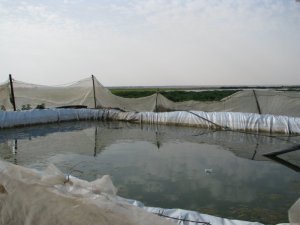
Gazans always have to come up with new solutions for surviving. This plastic irrigation pool is one of them, the tunnels are the other ...
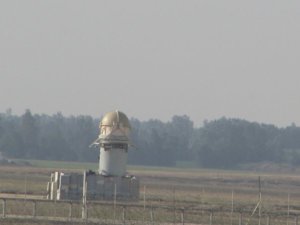
This is an unmanned automatic tower which lines the border at regular 1 km intervals. It opens like a (nasty) flower if movement is detected and it can fire by remote control. And than Israelis talk about the Gazans' hand-made Qassam rockets being a serious threat!
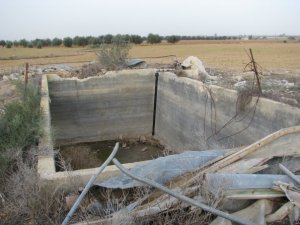

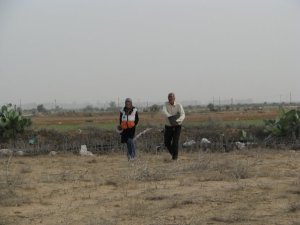
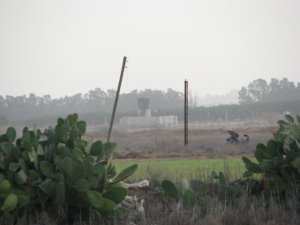





Thanks for caring 😀